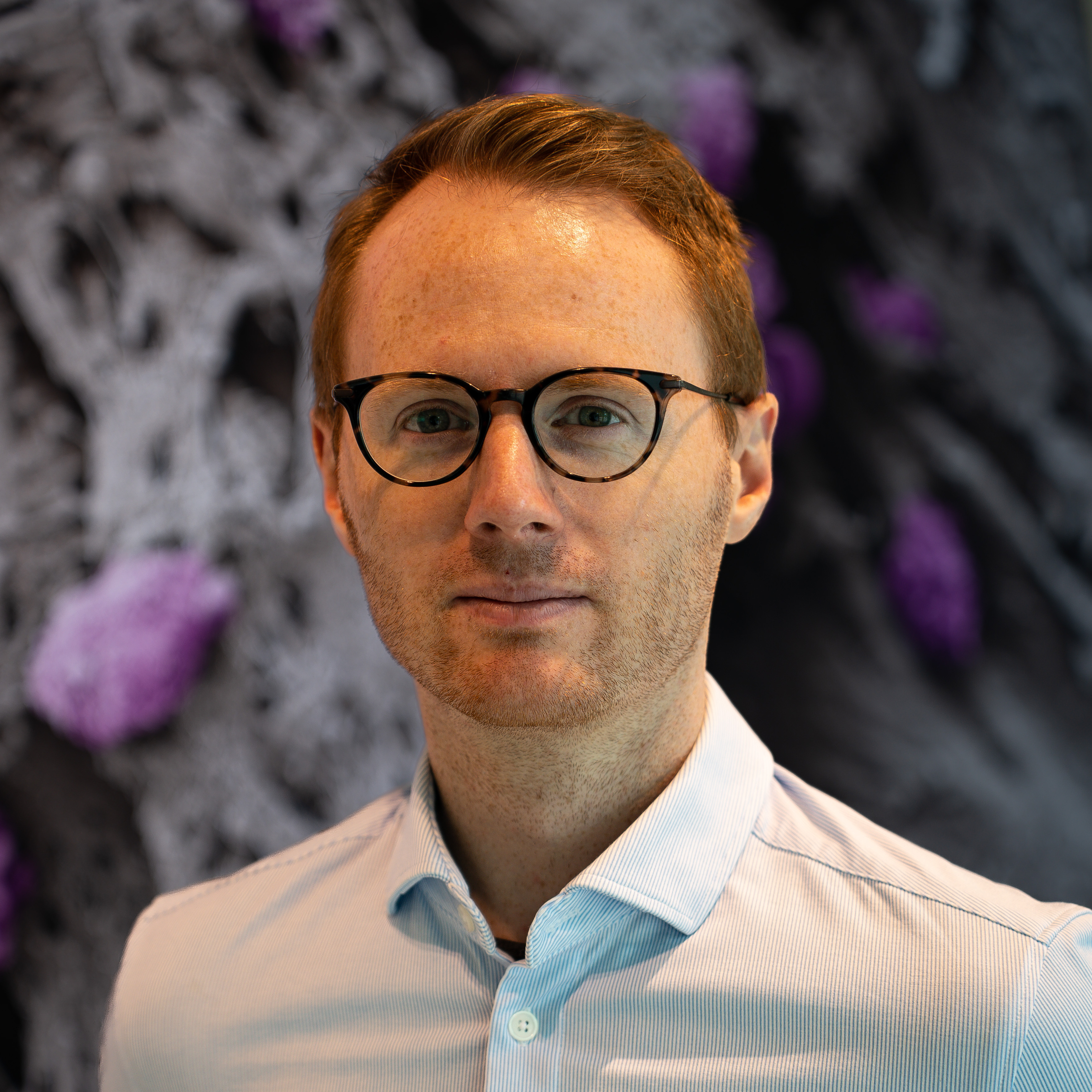Dr. med. Veronika Bahlinger

Dr. med. Veronika Bahlinger
E-Mail-Adresse: Veronika.Bahlinger@med.uni-tuebingen.de
Quote
“This Clinician Scientist program enables me to focus on my research projects which have been developed during the first years of residency. In addition, as I am a scientist, physician and working mum this program helps me to integrate everything and interact flexible. This allows me to enhance and to focus on my research and to develop during my residency.”
Project
Investigation of immune evasion mechanisms of cancer cells have led to the clinical use of immune checkpoint inhibitors (ICIs) against PD-1 and PD-L1 in urothelial bladder cancer (UBC). However, one major problem is that only 20% of ICI-treated patients respond to the therapy. To improve patient´s selection, and to protect non-responder of unnecessary treatment, a thorough investigation of immune-cancer cell interactions in the UBC immunological tumor microenvironment (TME) is urgently needed to understand the complexity. In my project, I will investigate tissue from ICI-treated UBC patient cohorts to identify cell-cell-interactions of the UBC TME to understand its spatial composition and how this is related to therapy response. In my project, I will use state-of-the-art spatial technologies, including CO-Detection by indEXing (CODEX) to build a spatially resolved single-cell map of UBC patients treated with immunotherapy. Deciphering the tissue architecture of treated UBC will detect advanced immunophenotypes which will better stratify UBC patients and will improve immunotherapy responses.
Dr. med. Lukas Beichert

Assistenzarzt & wissenschaftlicher Mitarbeiter
Telefonnummer: 07071 29-
E-Mail-Adresse: lukas.beichert@med.uni-tuebingen.de
Quote
Thanks to the MINT-CS program, I can combine clinical care with research on innovative technologies that support the development of future therapies.
Dr. med. Carolin Blumendeller

Ärztin in Weiterbildung
Telefonnummer: 07071 29-
E-Mail-Adresse: carolin.blumendeller@med.uni-tuebingen.de
Publikationen: Publikationsliste
Quote:
“My research focuses on advancing CAR T cell therapies to overcome current limitations in solid tumors and unlock new treatment options for patients. The MINT Clinician Scientist Program provides the ideal framework to pursue this vision — combining protected research time, mentorship, and interdisciplinary exchange that empower me to connect cutting-edge science with patient care.”
Project
Chimeric antigen receptor (CAR) T cells have shown impressive success against haematological malignancies, primarily targeting extracellular antigens in an MHC-independent manner. However, CAR T cell efficacy in solid tumors remains limited due to challenges such as low antigen density, antigen heterogeneity and poor CAR T cell persistence.
The intracellular KRAS(G12C) mutation, a common oncogenic driver in solid tumors, was previously considered an inaccessible target for CAR T cell therapy. However, recent studies show that KRAS(G12C) inhibitors like Sotorasib and ARS-1620 bind covalently to the mutant protein, forming complexes that are processed and presented as neoantigens on the cell surface. Building on this, I aim to develop TCR-mimic (TCRm) CAR T cells targeting the inhibitor-KRAS(G12C) peptide-MHC complex on tumor cells treated with these inhibitors to improve CAR T cell efficacy. My longterm goal is to extend the overall strategy to other intracellular oncogenic mutations with a special focus on pediatric solid tumors.
Dr. med. Christian Boßelmann

Clinician-Scientist
Telefonnummer: 07071 29-0
E-Mail-Adresse: christian.bosselmann@med.uni-tuebingen.de
Publikationen: Publikationen
Quote
“I believe that every individual with epilepsy deserves personalized care. My work combines clinical and molecular genetics with machine learning to improve our understanding of epilepsy – towards tailored treatments and improved outcomes.”
Dr. med. Daniela Bulla-Miely
Dr. med. Daniela Bulla-Miely
Einrichtung:
Department of Neurology and Epileptology / Hertie Institute for Clinical Brain
Research
Quote
Understanding a disease and its pathophysiological mechanisms is the foundation for developing targeted and personalized therapies. As a Clinician Scientist, my goal is to bridge the gap between bench and bedside — to translate these insights into improved treatments for patients.
Project
The recently identified spinocerebellar ataxia type 27B (SCA27B) represents one of the most common adult-onset ataxia syndromes, characterized by a slowly progressing pancerebellar syndrome. It is caused by an autosomal dominant intronic GAA repeat-expansion in the fibroblast growth factor 14 (FGF14) gene. The K+ channel blocker 4-aminopyridine (4-AP) has shown beneficial treatment effects in most SCA27B patients, however, the underlying pathophysiological mechanisms remain poorly understood.
In this project, an Fgf14 knockout mouse model mimicking the human condition will be used to investigate the functional consequences of 4-AP treatment. Of note, the FGF-14 protein interacts with and modulates voltage-gated Na+ channels that are abundantly expressed in the cerebellum. Electrophysiological recordings from acute cerebellar slices will be performed to elucidate how 4-AP restores disrupted cerebellar synaptic transmission and impaired neuronal firing. Furthermore, the impact of 4-AP on motor coordination and behavioral performance will be evaluated in vivo.
Dr. med. Fehime Kara Eroglu

Fachärztin für Kinder- und Jugendheilkunde
Telefonnummer: 07071 29-
E-Mail-Adresse: fehime.eroglu@med.uni-tuebingen.de
Publikationen: Pubmed
Quote
The clinician scientist program would provide me with the necessary time, support and training to pursue my clinically relevant, yet basic research-oriented project on FMF/pyrin and advance my career. It will also provide a framework for qualifying myself further as a researcher clinician and thus a catalyst for my progress.
Project
Autoinflammation reference center Tübingen (arcT) is one of the most experienced and leading autoinflammation centers in Europe and worldwide taking care of more than 1700 patients with autoinflammatory diseases (AID) yearly. The most common diagnoses in our center are IL-1 related autoinflammatory diseases mainly FMF. The scientific progress in genetics and immunology have drastically improved the understanding and treatment of autoinflammatory diseases but there are still many unknowns in the field, mainly specific biomarkers und targeted therapies of autoinflammation. For example, the efficacy of the treatment of FMF patients with colchicine is unpredictable and as a clinician, I would like to decipher the mechanistic basis for why some patients respond, whilst others do not. I hope my findings like many other recent progresses in understanding of the AID will pave the way of understanding many other common diseases such as infections, cardiovascular diseases and host-microbe interactions
Dr. med. Daniel Essigke

Arzt in Weiterbildung
Telefonnummer: 07071 29-83172
E-Mail-Adresse: daniel.essigke@med.uni-tuebingen.de
Publikationen: Publikationen
Quote
“For me, scientific work means gaining a deeper understanding of the physiological and pathophysiological processes relevant to the development and treatment of my patients' diseases. From the MINT-CS program, I hope to receive guidance and support on the path to becoming a Clinician Scientist and the opportunity for open spaces to drive research.”
Project
The metabolic syndrome (MS) is a cluster of risk factors and can lead to multiple vascular complications. Most of the patients with MS suffer from insulin resistance (IR), which can contribute to the development of proteinuric chronic kidney disease (CKD). Disturbance of sodium homeostasis resulting in sodium retention and hypertension is common in MS. To get a better pathophysiologic understanding a novel model of insulin resistance and proteinuric kidney disease will be established. Furthermore in-depth investigations in proteolytic ENaC activation and its impact on sodium homeostasis in the setting of proteinuric CKD and IR are planned as well as studies on the role of aldosterone in proteolytic ENaC activation and diuretic resistance. As a goal there should be a better understanding of pathophysiologic processes increasing the vascular burden of MS.
Dr. med. Adrian Fehn

Quote
The exponential growth in medical complexity demands close integration of interdisciplinary clinical care and biomedical research to reciprocally advance patient-centered medicine and the scientific process itself. The MINT Clinician-Scientist Program provides an ideal framework for physician-scientists to build and strengthen this connection from early clinical training on.
Project
Head and Neck Squamous Cell Carcinoma (HNSCC) is characterized by interindividual and intratumoral heterogeneity, rising incidence rates of human papillomavirus (HPV)-associated disease, and immediate and severe loss of quality-of-life measures due to curative treatment approaches. Recently, neoadjuvant immune-checkpoint blockade (ICB) was approved in locally advanced, resectable HNSCC, marking a long awaited improvement in the standard of care. Yet only a fraction of patients benefit, and no reliable biomarkers have been established. In HPV-associated disease, presence of HPV-specific cellular immunity is associated with superior outcomes, and engineered HPV-specific T cells have shown clinical activity.
By deep spatial phenotyping of tumors from HNSCC patients treated with neoadjuvant ICB, we aim to characterize the determinants and temporal dynamics of response and resistance. In prospect of cellular therapy, we will isolate and characterize the HNSCC-infiltrating T cell compartment, quantify the influence and potential of HPV-specificity, and develop optimized selection and expansion protocols for clinical application.
Dr. med. Zofia Fleszar

Dr. med. Zofia Fleszar
E-Mail-Adresse: Zofia.Fleszar@med.uni-tuebingen.de
Quote
“The MINT-CS program will offer the necessary space to arrive and develop within my research area, while offering the support to progress as a Clinician Scientist. .”
Project
A significant share of degenerative ataxias is caused by pathogenic variants coding for ion channels. Next generation sequencing (NGS) techniques have expanded the number of known pathogenic variants as well as variants of unknown significance in these genes, including CACNA1A, KCNC3 and KCND3, among others. Since comprehensive longitudinal natural history studies are still missing in these patient cohorts, my project aims to study the clinical course and phenotypic spectrum in these conditions. Electrophysiological studies of mutant channels offer a promising opportunity of studying the functional consequences of variants in these genes, allowing to assess the pathogenicity of gene variants. Further, studying the effects of small molecules (such as 4-aminopyridine) on mutated ataxia channels may inform future therapeutic trials in patients and pave the way for personalized medicine.
Dr. Dr. med. Reka Agnes Haraszti

Nachwuchsgruppenleiterin und Ärztin in Weiterbildung
Telefonnummer: 07071 29-68948
E-Mail-Adresse: reka.haraszti@med.uni-tuebingen.de
Publikationen: Publikationen
Quote
“I believe in bridging basic science with patient care in order to realize the full translation potential of the RNA paradigm.”
Project
In this project my team develops RNA-modulators for T-cell immunotherapies. Specifically, we focus on donor lymphocytes - a T-cell-therapy given to hematopoietic stem cell recipients in order to prevent or to treat leukemia relapse. Donor lymphocytes, however, often induce severe graft-versus-host effects. Graft-versus-host effect is mechanistically very similar to the therapeutic graft-versus-leukemia effect. In this project we use a precision immunosuppression concept and apply various mixtures of chemically modified siRNAs and mesenchymal stem cell derived extracellular vesicles to T cells with the aims to (1) prevent graft-versus-host effects while preserving graft-versus-leukemia effects, and (2) induce longer lifespan of therapeutic donor lymphocytes. We use fully chemically modified siRNAs similar to approved siRNA drugs - warranting high translation potential to this project. We aim to set the stage for further clinical development of RNA-based ex vivo treatments of donor lymphocytes - making this T-cell-immunotherapy safer and more efficient for all patients.
Dr. med. Andreas Joos
Dr. med. Andreas Joos
Einrichtung: Abteilung Neurologie mit Schwerpunkt neurovaskuläre Erkrankungen
PD Dr. med. Benedikt Kaufmann
Dr. med. Philipp Klocke

Assistenzarzt & Wissenschaftlicher Mitarbeiter
E-Mail-Adresse: philipp.klocke@med.uni-tuebingen.de
Dr. med. Cornelius Kronlage

Assistenzarzt und wissenschaftlicher Mitarbeiter
Telefonnummer: 07071 29-
E-Mail-Adresse: cornelius.kronlage@med.uni-tuebingen.de
Publikationen: Pubmed
Quote
“I find it fascinating to be working towards the translation of technological achievements into clinical practice. Through the MINT-CS program, I have time and receive support to work on my project on MR imaging in epilepsy.”
Project
In drug-resistant focal epilepsy, identifying small epileptogenic lesions by magnetic resonance imaging (MRI) is crucial because it enables epilepsy surgery – a treatment that can significantly reduce seizure activity and improve overall outcomes. The goal of this research project is to improve the detection of such lesions, in particular focal cortical dysplasias, by using ultra-high field 9.4T MRI, which provides higher-resolution images than standard clinical 3T MRI. This project is a collaboration between the Department of Neurology and Epileptology (Prof. Holger Lerche) and Prof. Esther Kühn’s group “Translational Imaging of Cortical Microstructure” at the Hertie-Institute for Clinical Brain Research. We will apply specialized acquisition and post-processing techniques to characterize known lesions in detail at the ultra-high field strength. Subsequently, we aim to develop a pipeline for the automated detection of epileptogenic lesions using 9.4T MRI data.
Dr. rer. nat. Stefanie Liebe

Clinician Scientist /Resident in Neurology and Epileptology
Telefonnummer: 07071 29-80442
E-Mail-Adresse: stefanie.liebe@uni-tuebingen.de
Publikationen: Publikationen
Dr. med. Benjamin Mayer

Assistenzarzt - Clinician Scientist
Telefonnummer: 07071 29-86621
E-Mail-Adresse: benjamin.mayer@med.uni-tuebingen.de
Publikationen: Publikationsliste
Quote
“The support provided by the MINT Clinician Scientist Program enables me to carry out time-intensive innovative research projects while at the same time performing my duties in pediatric surgical patient care and teaching. Integrated into a scientific network and a structured mentoring program, I can thus continue my path as an academic pediatric surgeon with the best possible support.”
Project
Regardless of established risk factors, approximately 10% of children with embryonal rhabdomyosarcoma of the bladder and prostate develop local tumor recurrence after bladder-preserving resection and brachytherapy. It stands to reason that this group of patients would benefit from extended therapy. In this project, funded by the MINT-Clinician Scientist program, tissue and plasma samples from 54 patients treated in our department for embryonal rhabdomyosarcoma of the bladder and prostate will be analyzed and compared between patients with and without local tumor recurrence. The following potential molecular risk factors will be investigated in 4 projects: Molecular resection status, DNA methylation profile and transcriptome, immunological tumor microenvironment and molecular composition of extracellular vesicles. Identification of molecular risk factors for embryonal rhabdomyosarcoma of the bladder and prostate could enable optimization of preoperative treatment planning, adjustment of postoperative brachytherapy and, if necessary, personalized adjuvant systemic therapy.
Dr. med. Peter Müller-Wöhrstein

Arzt in Weiterbildung /Physician-Scientist
E-Mail-Adresse: peter.mueller@med.uni-tuebingen.de
Quote
The beauty of my research as a clinican scientist lies in highlighting patterns within complex biological disease models that in turn can benefit patients.
Project
Precision medicine for ultra-rare genetic diseases needs approaches that target functionally linked mechanisms. This project investigates a severe developmental and epileptic encephalopathy affecting 30 patients globally, caused by the p.(Pro405Leu) loss-of-function variant in the KCNA2 gene which encodes the voltage gated potassium channel subunit KV1.2.
We generated a heterozygous knock-in mouse model that mimics the human condition, including premature lethality and epileptic seizures. We want to test three precision medicine strategies:
- Potassium current modulation: Niflumic acid, a repurposed drug previously studied for a related potassium channel subunit.
- Sodium channel reduction: Antisense oligonucleotide (ASO) to target the Scn8a gene.
- Sodium current blockade: PRAX330, a drug that blocks persistent sodium currents.
Treatment efficacy will be evaluated by monitoring the mice's survival and conducting video electroencephalography (EEG). The findings could advance precision medicine for ultra-rare diseases by focusing on interconnected functional systems to reach the threshold of orphan drug viability.
Dr. med. Benedikt Obermaier

Arzt in Weiterbildung
E-Mail-Adresse: benedikt.obermaier@med.uni-tuebingen.de
Publikationen: Publikationen
Quote
“The MINT Clinician Scientist program provides key prerequisites for aligning clinical work and impactful research, enabling me to concurrently pursue my clinical and research interests at the intersection of infectious diseases, immunology and hematology.”
Project
Opportunistic infections and reactivation of double-stranded DNA virus infections (eg, CMV, EBV, ADV) represent a major challenge in states of immunosuppression, especially in the context of hematopoietic cell transplantation. Their treatment is often complicated by drug resistance and toxicities. An alternative promising treatment option is based on restoring T cell immunity through the adoptive transfer of pathogen-specific T cells from healthy donors.
My project aims at the generation and robust functional characterization of improved multi-pathogen-specific T cell products enriched with early differentiated T cells. Early differentiated T cells, such as T memory stem cells (Tscm), have been associated with superior long-term persistence, self-renewal, and reconstitution of a diverse T cell compartment, making them a promising T cell subtype for adoptive immunotherapy.
The project is based on a triangular collaboration between the Department of Infectiology of the University of Basel, the Department of Internal Medicine 2 (UKT) and the Department of Virology (UKT).
Dr. med. Malte Rörden

Physician-Scientist / Arzt in Weiterbildung
E-Mail-Adresse: malte.roerden@med.uni-tuebingen.de
Publikationen: Publikationen (PubMed Verzeichnis)
Quote
„To improve the lives of cancer patients, we need both excellence in clinical care and continuous scientific progress – the MINT-CS programs allows me and other physician-scientists to contribute to that!“
Project
Acute myeloid leukemia (AML) is an aggressive hematological malignancy with a high mortality and an urgent need for more effective therapies. Despite the demonstrated significance of anti-leukemia T cell immunity for disease control, the biology and the factors governing the efficacy of anti-leukemia T cell priming remain poorly understood.
Our hypothesis is that priming of anti-leukemia T cells portrays a bottleneck for anti-leukemia immunity. We therefore use mouse models and human patient samples to study the biology of anti-leukemia T cell priming and the impact of leukemia antigen expression patterns on the efficacy of T cell priming.
The aim of the project is to gain a detailed understanding of the biology of T cell priming and the mechanisms limiting the induction of T cell responses in AML. These insights will support the prediction of GvL effects and hold promise to fuel the development of novel immunotherapy approaches to enhance anti-leukemia immunity.
Herrn Dr. med. Benjamin Ruf

Arzt in Weiterbildung & Arbeitsgruppenleiter
E-Mail-Adresse: benjamin.ruf@med.uni-tuebingen.de
Publikationen: PubMed
Publikationen: Google Scholar
Quote
“The DFG-funded MINT-CS program provides a fantastic platform to connect clinician scientist from various backgrounds and allows us to work at the exciting interface between basic science and clinical patient care. The accompanying interdisciplinary curriculum also supports me in pursuing our research goal to develop novel immunotherapeutic strategies for the benefit of patients with gastrointestinal cancers.”
Project
In our lab, we aim to expand our knowledge of the composition, phenotype, and organization of the tumor immune microenvironment (TiME) in gastrointestinal cancers with the goal to ultimately improve patient care. Our research is located at an exciting interface between basic immunology, translational and clinical research. We use clinical data to guide our research focus, we use systems biology approaches to build hypotheses and then test these hypotheses in functional in vivo and in vitro models. We employ complementary experimental strategies to investigate the TiME in patient samples including scRNA-seq, spatial proteomics and high-dimensional spectral cytometry. Using these approaches, we study how reciprocal communications between the innate and adaptive immune system, stomal cells and cancer cells are altered in response to tumor initiation, progression, and response to (immuno)therapy. One focus of our research program is to investigate the role of tissue-resident lymphocytes, in particular mucosal-associated invariant T (MAIT) cells, in the context of cancer.
Arvid Sandforth
Leontine Sandforth

Ärztin in Weiterbildung
E-Mail-Adresse: leontine.sandforth@med.uni-tuebingen.de
Dr. med. Simon Scherer

Assistenzarzt und wissenschaftlicher Mitarbeiter
Telefonnummer: 07071 29-86621
Faxnummer: 07071 29-4046
E-Mail-Adresse: simon.scherer@med.uni-tuebingen.de
Publikationen: Übersicht Publikationen - externer Google Scholar Link
Quote
"The MINT-CS program enables me to carry out my scientific work in an appropriate manner and with the intensity that the complex topic deserves."
Project
In my project I would like to establish cadavers from human body donors as an aseptic resource to isolate vital nerve and muscle cells from the intestine in the intermittent life phase. My project will also provide important knowledge by comparing existing and new intestinal resections from children, adults and the deceased over the course of the project using modern immunofluorescence histology and ultrastructural analysis.
Dr. med. Jan Schröder

Dr. med. Jan Christian Schröder
Arzt in Weiterbildung
Telefonnummer: 07071 29-82711
E-Mail-Adresse: jan.schroeder@med.uni-tuebingen.de
Publikationen: Publikationen
Quote
“Translational research represents an invaluable opportunity to develop myself and tackle complex medical issues in a holistic way.”
Project
The last decades have seen an unprecedented leap in our understanding of cancer biology. At the same time, outcomes for many patients with leukemia and other malignancies remain poor. In this translational research project, I will explore the mechanisms of treatment failure in acute myeloid leukemia (AML) by focusing on the interaction of leukemic stem cells (LSCs) with the tumor immune microenvironment (TIME).
LSCs are the major cause of relapse and treatment failure in AML due to their resistance to chemotherapy and antitumor immunity. To effectively eliminate LSCs, we need to discover their specific vulnerabilities. Here, I will use cutting-edge methods to identify and characterize LSCs at the single cell level and visualize their spatial interaction with other cells in the TIME. This will help to find new markers and molecular mechanisms of treatment resistance and pave the way for precision medicine approaches in AML.
Dr. med. Günalp Uzun

Facharzt für Transfusionsmedizin
Telefonnummer: 07071 29-81656
E-Mail-Adresse: guenalp.uzun(at)med.uni-tuebingen.de
Publikationen: Publikationen auf PubMed
Quote
“Physician participation in basic medical research is undeniably critical to the development of patient-centered solutions to clinically relevant problems.”
Project
Immune thrombocytopenia (ITP) is a condition in which antibodies to platelet antigens destroy platelets, resulting in a low platelet count. Interestingly, bleeding in ITP patients often does not correspond to the platelet count. Furthermore, recent evidence suggests that ITP patients are at increased risk of thrombosis despite low platelet counts. A better understanding of hemostatic regulation in ITP patients is critical to prevent bleeding complications and avoid treatment failure or thrombosis. The platelet phenotype in patients with ITP remains poorly understood. Procoagulant platelets are a distinct platelet subpopulation that act as a scaffold to support the assembly of prothrombinase and tenase complexes, leading to thrombin burst, fibrin formation and aggregation. In this project, we will investigate the mechanisms involved in the modulation of the platelet phenotype, particularly the formation of procoagulant platelets, in ITP patients and its potential impact on clinical outcomes such as bleeding and thrombosis.
Dr. med. Yuxiang Ye

Arzt in Weiterbildung, DFG Clinician-Scientist
E-Mail-Adresse: yuxiang.ye@med.uni-tuebingen.de
Quote
“MINT-CS program supports early career clinicians with passion for research to bring real impact from bench discoveries to clinical medicine.”
Project
Myocarditis, a frequent cause of sudden cardiac death, is defined as inflammation of myocardium, typically resulting from cardiotropic viral infection. The pathogenesis of viral myocarditis includes both the direct damage mediated by viral replication and the indirect injury induced by the host immune responses. Clinical diagnosis of myocarditis relies on a combination of clinical features, laboratory analyses and imaging findings. However, a definitive diagnosis is based on endomyocardial biopsy, which is not routinely employed due to concerns of complications.
The aim of the project is to develop a novel and clinically translatable imaging strategy, which can non-invasively and quantitatively visualize both the innate and adaptive immunity dynamically. This approach has the potential to facilitate the diagnosis by serving as a non-invasive imaging ‘Biopsy’ in detecting myocarditis lesions and improve the management of myocarditis patients by providing new insights of the disease and discovering reliable prognostic markers for worse outcomes.
Dr. med. Jan Zlamal

Telefonnummer: 07071 29-69033
E-Mail-Adresse: jan.zlamal@med.uni-tuebingen.de
Publikationen: Publikationen
Quote
“From clinical observation to novel therapeutic strategies-Translational research opens the gate for innovation and change of paradigms in modern medicine”
Project
Heparin-induced thrombocytopenia (HIT) is an immune-mediated prothrombotic disorder leading to life-threatening thromboembolic events despite low platelet counts. HIT is caused by antibodies of the immunoglobulin G subclass that recognize complexes of the endogenous protein platelet factor 4 (PF4) and heparin. These immune complexes harbor the potential to activate platelets and multicellular effector mechanisms that drive a prothrombotic condition in patients. Despite platelets are main actors in HIT, a greater understanding regarding the contribution of different antibody-induced platelet subpopulations in this complex coagulation disorder is missing. Hence, this project aims to investigate the relevance of procoagulant PLTs, a PLT subpopulation that is increasingly identified to harbor dramatic prothrombotic potential, in a prospective clinical study. Additionally, the crosstalk of antibody-induced procoagulant PLTs with different leukocyte subsets will be investigated via the of ex and in vivo models. Findings of these studies will help to identify new mechanisms and therapeutic targets to treat the prothrombotic condition typically observed in HIT patients.
